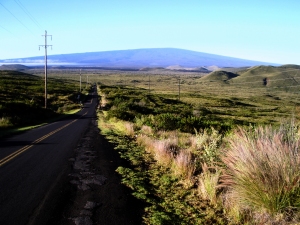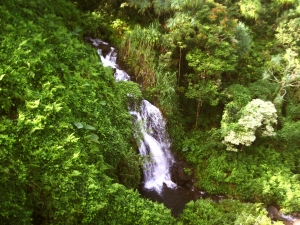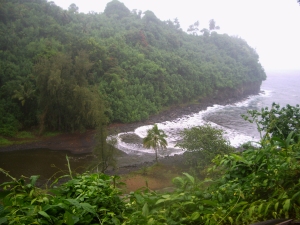by Donald B. MacGowan
Long the subject of wild rumors of danger, rental car agency blacklisting and resident grumbling, Hawaii's Highway 200, more commonly known as The Saddle Road, has undergone significant rebuilding and realignment over the past few years. What used to be a fairly rough, but also reasonably safe, drive between Kailua Kona and Hilo over the saddle between Mauna Kea and Mauna Loa is now largely an easy drive on a new, wide, first-class highway. To be sure, construction is incomplete and continues, particularly on the Kona side, and conditions are still poor in places; however, it's no longer the challenging white-knuckle exercise it once was.
This blog post is just a photo essay, meant to whet your appetite; a detailed description for driving this road trip can be found here.
The Saddle Road accesses the incomparable, vast, mysterious and awe-inspiring wilderness that is the roof of Hawaii. From the sere basalt desert of North Kona, over the grassland savanna, fabulously lunar lava flows to the alpine tundra and icy heights of the upper slopes and summits of the world's largest mountains, the road winds down into the wet-side of Hawaii to rainy Hilo with its lava caves, flower-choked canyons, waterfalls too numerous to catalog and jungle canyon beaches. Really, this drive is one of the most unique, incredible scenic drives on Hawaii.
The land around the junction of of Highway 190 and Highway 200, running up to the Saddle itself and down to Kawaihae was called "The Kingdom of the Five Mountains by the Hawaiians. From this area, Mauna Kea, Mauna Loa, Kohala Volcano, Haulalai Volcano and Haleakala on Maui can be seen.
A trip up Mauna Kea, at least to the Visitor's Information Station, is a must for anyone traveling between Hilo and Kona along this road. There, rangers at the station can help you decide if you are prepared to drive the 12 miles of fairly challenging dirt road to the summit at almost 13, 800 feet.
At the summit of the saddle is also Kipuka Huluhulu, a wonderful window of forest and wildlife serendipitously saved from annihilation by lava flows from Mauna Loa.
An interesting, but short, hike to the summit provides amazing views of the saddle area and great bird-watching.
Down into the jungle wetness of the Hilo side, just on the outskirts of Hilo Town, is Kaumana Caves Park, an enormous lava tube you can climb down into the cave via a set of concrete stairs. Further exploration of the cave, wither up or downhill is fascinating and easy, just be sure to wear a hard-hat and bring at least 3 sources of light (flashlights) per person if you venture past the opening.
Immense, jungle-filled gulches dissect the lower flanks of Mauna Kea north o Hilo Town, running down to the sea to uncrowded, amazing beaches, such as the one pictured at Hakalau.
Now that you've been over the roof of the Island of Hawaii, head into Hilo Town for some Island-style fun, food and shopping.
For more information on traveling to Hawaii in general and touring the Big Island in particular, please also visit www.tourguidehawaii.com and www.lovingthebigisland.wordpress.com For more information on the author, please go here.
All media copyright 2009 by Donald B. MacGowan; all rights reserved.




















No comments:
Post a Comment